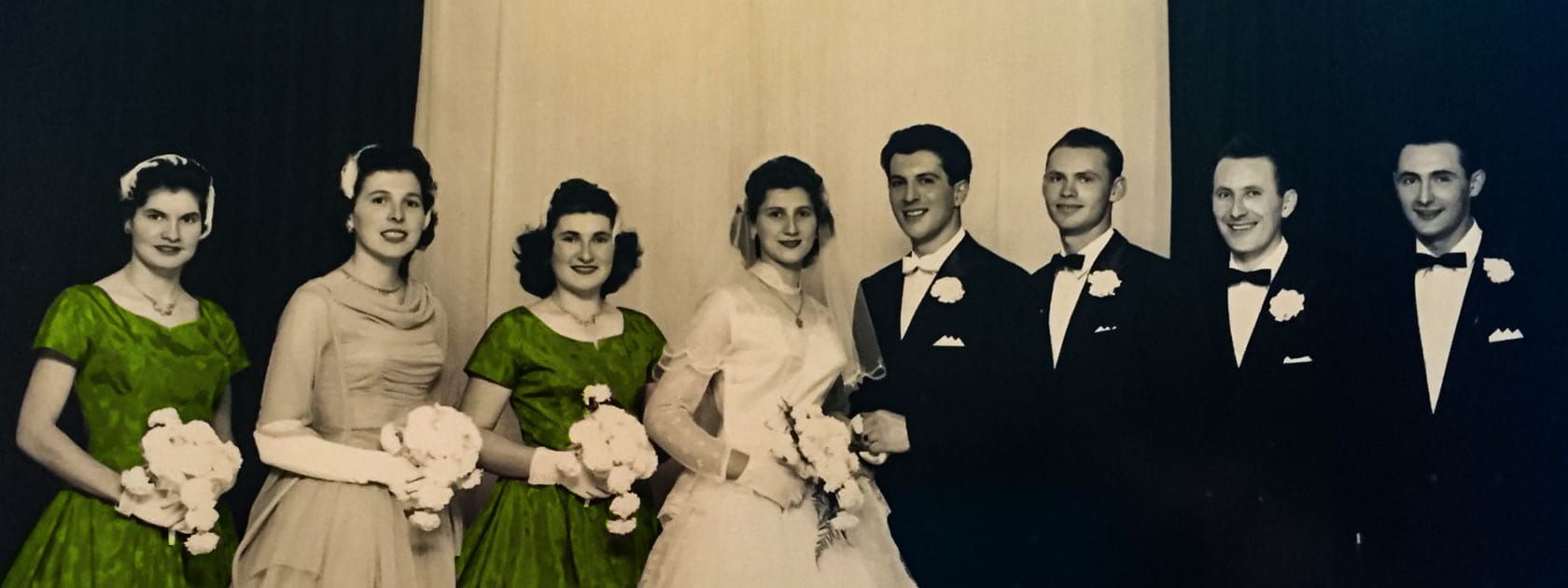Written by Lily Gomez

Table of Contents
Introduction
The purpose of the interviews conducted by Lily Gomez was to compare the lived experience of a first-generation Italian Canadian to that of a first-generation European Canadian and document the commonalities and cultural differences between the children of immigrants. This was accomplished by first interviewing Blair Ceolin, a Generation X Italian Canadian business owner, who offered his unique perspective on life as a child of an Italian immigrant. Then an interview was conducted with Rafael Gomez, Lily’s father and a Generation X Hispanic/Portuguese Canadian Chief Operating Officer, who provided insight and a cultural parallel to Blair’s upbringing. By interviewing two similarly aged first-generation Canadians the goal was to document two unique yet similar experiences from both within, and outside of, the Italian community. The interviews were documented via voice memos on an iPhone and then presented alongside a series of photos provided by both interviewees which document their relatives, life growing up, and unique family history.
Interviews: Conversations with Blair Ceolin and Rafael Gomez
Interview Transcripts
Below a transcript of the video can be downloaded and accessed.

Analysis
In reviewing the interviews, one of the most striking connections emerged between my interviewees, both of which emphasized the deeply rooted value of hard work instilled in them by their families and communities. Despite differing cultural backgrounds, both Blair and Rafael described growing up in environments where a strong work ethic and staying “with your own” was not only expected but actively celebrated. These values were passed down through witnessing the labour-intensive jobs their parents worked and the pride associated with contributing meaningfully to both family and society. The stories they shared during their interviews had many similarities with the content from our course readings, particularly those that covered how intergenerational expectations shape the cultural identity of the younger generations and how a majority of the older Italian and European immigrants came to Canada for work.
What stood out to me was how these values translated into Blair and Rafael’s adult lives. Both of them spoke about feeling a strong sense of responsibility to maintain a good work ethic, given how hard their parents or grandparents worked to come to Canada. For Rafael, more challenges were present due to the language barriers that existed between his parents and the educational practices in Canada, while Blair grew up in a predominantly English-speaking home and didn’t encounter the struggles of a language barrier in his day-to-day life. Also, Rafael played the role of translator for his parents, which impacted his daily life and would often pull him into roles that most children don’t usually play, such as doing taxes or speaking to government officials.
I feel that interviewing two first-generation Canadians of parallel European backgrounds and similar age showed that culturally their upbringing and the neighbourhoods they grew up in were extremely similar. Blair’s Italian upbringing emphasized good family values and a hard work ethic, and Rafael’s Portuguese-Hispanic upbringing brought similar standards to his childhood. Both their families came to Canada from non-English-speaking countries, which was a barrier for Blair’s grandparents and Rafael’s parents. This language barrier was overcome by the generation that followed. Blair’s father and Rafael’s brother came to Canada as children and learned English. As the subsequent generations become further from the immigration process, language becomes less of an issue, and the children become integrated into the culture of Canada. An interesting facet with Blair is the pride he had for being Italian, despite never going to Italy or speaking the language. I think Rafael’s lived experience may be tempered by the fact that his parents left Europe in their teens and early twenties and, prior to coming to Canada, lived two decades in Brazil, leaving his ties to Portugal, Spain, or even Brazil weakened compared to Blair’s perceived connection to Italy.
Food seems to play an integral role for both Blair and Rafael and seems to prompt good memories for both men. Food is important for not only sustaining a body, but it also activates memory and can convey love and importance. Blair’s grandmother’s sauce is very important to him, and it is unfortunate that he doesn’t have the recipe. Blair doesn’t have the cooking aptitude to make his grandmother’s sauce, but luckily the recipe is being preserved by his aunt. Rafael spoke of food as he did of family; they are both important and are what make a house a home. He detailed how his mother frequently cooked and passed down her recipes to him, with cod cakes remaining a staple tradition around the Christmas holiday. Clearly in both the Italian and the Portuguese-Hispanic cultures, bringing food and recipes from “back home” is very important and often extends into future generations as the traditions are handed down from parent to child.
For both Blair and Rafael, their families came to Canada with very few possessions, but the values, ethics, memories, and food recipes they brought inside themselves are of far more importance than material things. Their families brought some of their culture with them to a new country with the hopes that they could have a better and safer life. Both Rafael and Blair show how the traditions that perpetuate Italian, Hispanic, and Portuguese values are still maintained within the first-generation European Canadian experience and will continue with future generations.
Reflection
I have an interest in broadening my understanding of cultural identities outside of my own. I was drawn to this course because I found the prospect of documenting and archiving history to be an interesting opportunity. However, as a non-Italian, this project itself presented some minor challenges. I found that it was difficult to find an Italian Canadian interviewee, which led me to think introspectively about the lack of Italian Canadians that exist within my immediate circle of family and friends. As a person of Hispanic-Canadian descent, I, myself, know many other Hispanic and Portuguese people within my community, be it direct family or family friends, but I’ve come to be aware of the distinct lack of diversity within most family circles.
I was presented with the opportunity to interview Blair, as he is a longtime friend and business associate of my father, which inspired me to interview both to bring their unique perspectives to this project. I wanted to authentically represent both of their experiences while having a reference point of my own through my father’s experiences as the child of immigrants. I found that when I first began the interviewing process, I wasn’t particularly comfortable with the role, as I find recording myself to be somewhat stressful; however, as the interviews progressed, I found myself becoming more comfortable with asking follow-up questions, as I was extremely interested in the stories that were being shared with me. The interviews themselves were both extremely insightful. Though I already know a handful about my father’s experiences growing up, I still found that I learned many different things about his experiences as well as my grandparents’ experiences. The stories that Blair shared with me also broadened my understanding of the Italian Canadian experience and correlated to the materials that we covered in class, with him detailing how his grandparents immigrated to Canada for work purposes and found themselves working in factories. I believe that my experience in conducting these interviews has helped to further develop my research, documentation, and critical thinking skills.
Overall, I found that this experience has deepened my interest in internet archival and historical documentation. If I were to approach this project once more, I think that I would perhaps take the opportunity to find a third participant to interview, either an older member of the Italian Canadian community or a direct Italian immigrant, in order to broaden the range of experiences I collected. Hearing many of the stories that Blair and my father shared reinforced the notion that culture does impact how you raise your family and interact with the world around you; it also reinforced my appreciation for the few cultural traditions that my family personally holds dear.
Gallery














Bibliography
All photographs have been approved for sharing from the private collections of Blair Ceolin and Rafael Gomez.
Gomez, Lily. “HUMN*3800 Italian Heritage Interviews.” YouTube, 19 Oct. 2025, www.youtube.com/watch?v=HV4ea9wZGqU; access at Italian Communities in Canada: Heritage, Cultural and Ethnographic Studies as of October 2025, https://www.italianheritage.ca.
How to cite this page:
MLA STYLE: Author. “Title.” Title of container, Other contributors, Number (vol. and/or no.), Publisher, Publication Date, Location (pages, paragraphs and/or URL, DOI or permalink). 2nd container’s title, Other contributors.
Gomez, Lily. “A Comparison of the First-Generation Canadian Experience: An Interview with Blair Ceolin and Rafael Gomez.” In Italian Communities in Canada: Heritage, Cultural and Ethnographic Studies, spurv. Teresa Russo. University of Guelph, 24 October 2025, Guelph (https://www.italianheritage.ca/2025/10/23/a-comparison-of-the-first-generation-canadian-experience-an-interview-with-blair-ceolin-and-rafael-gomez/). Italian-Canadian Narratives Showcase (ICNS).


